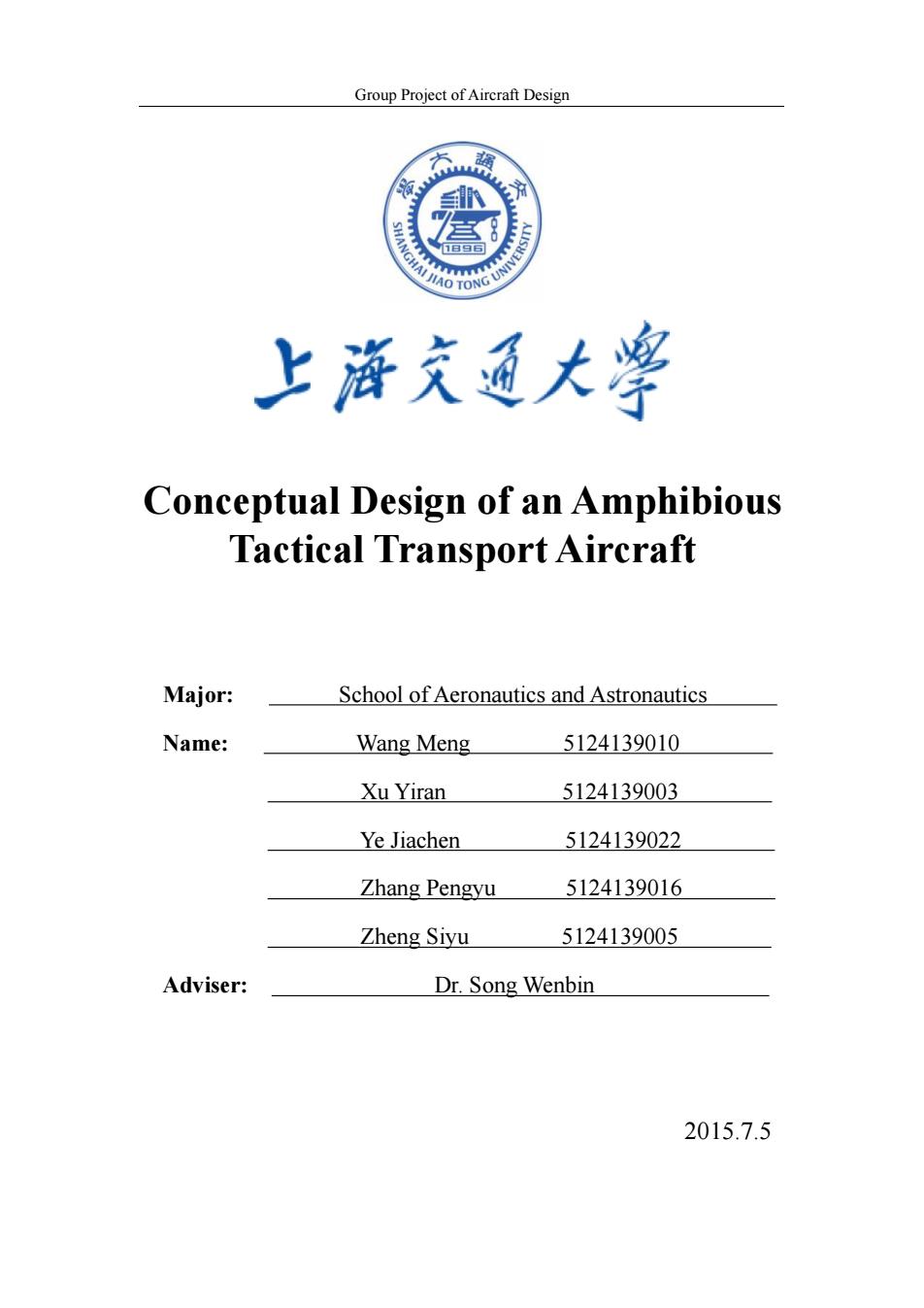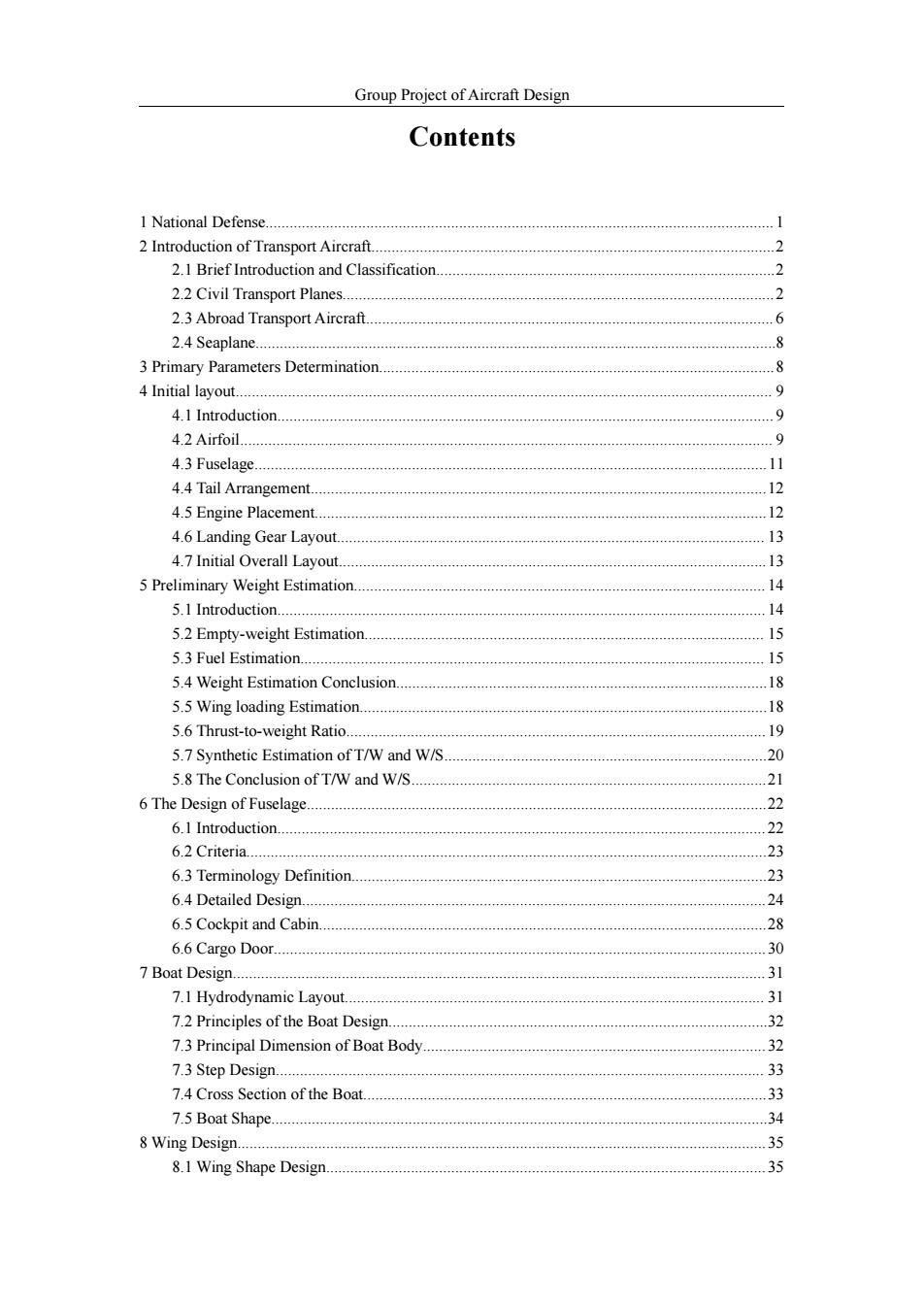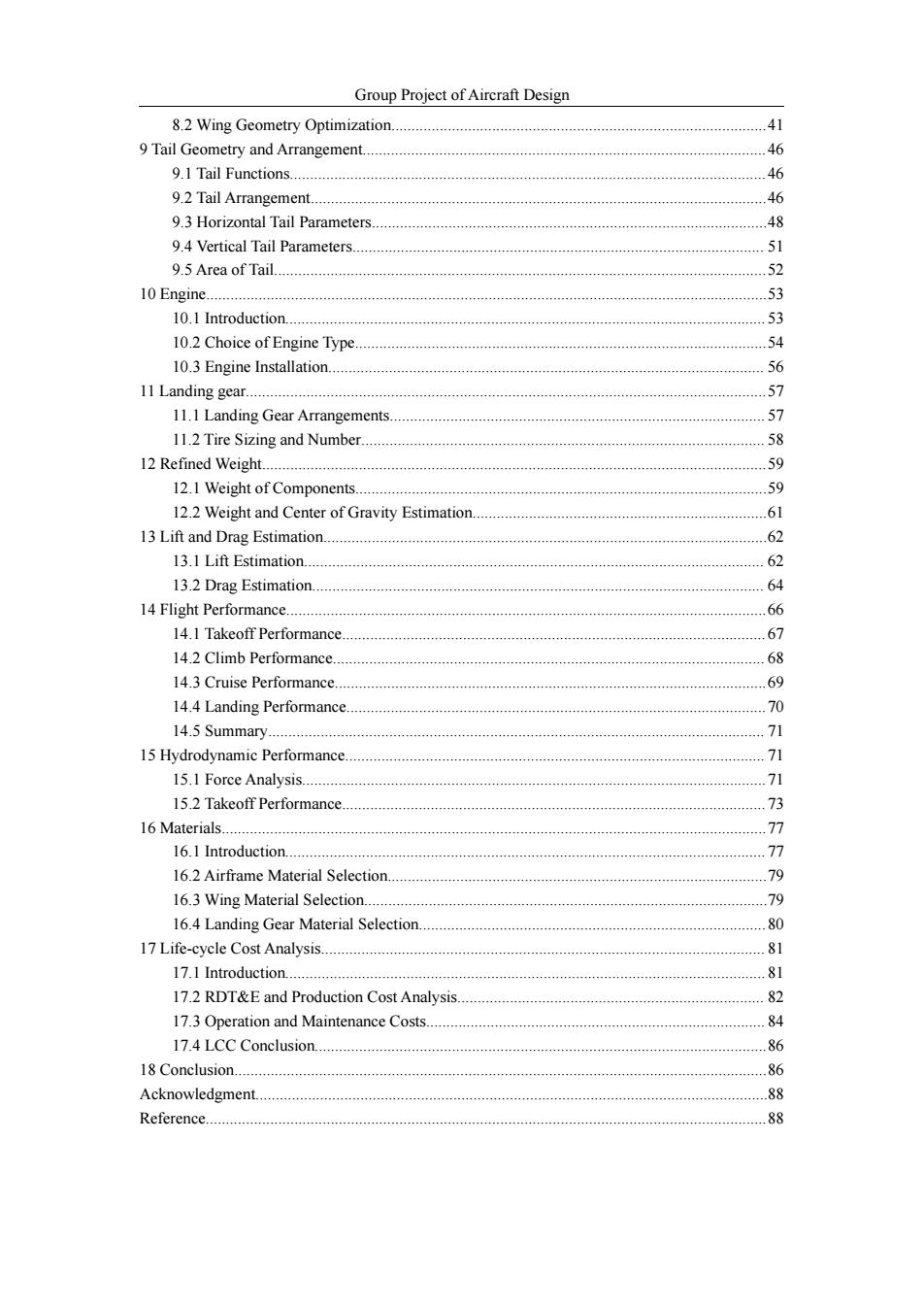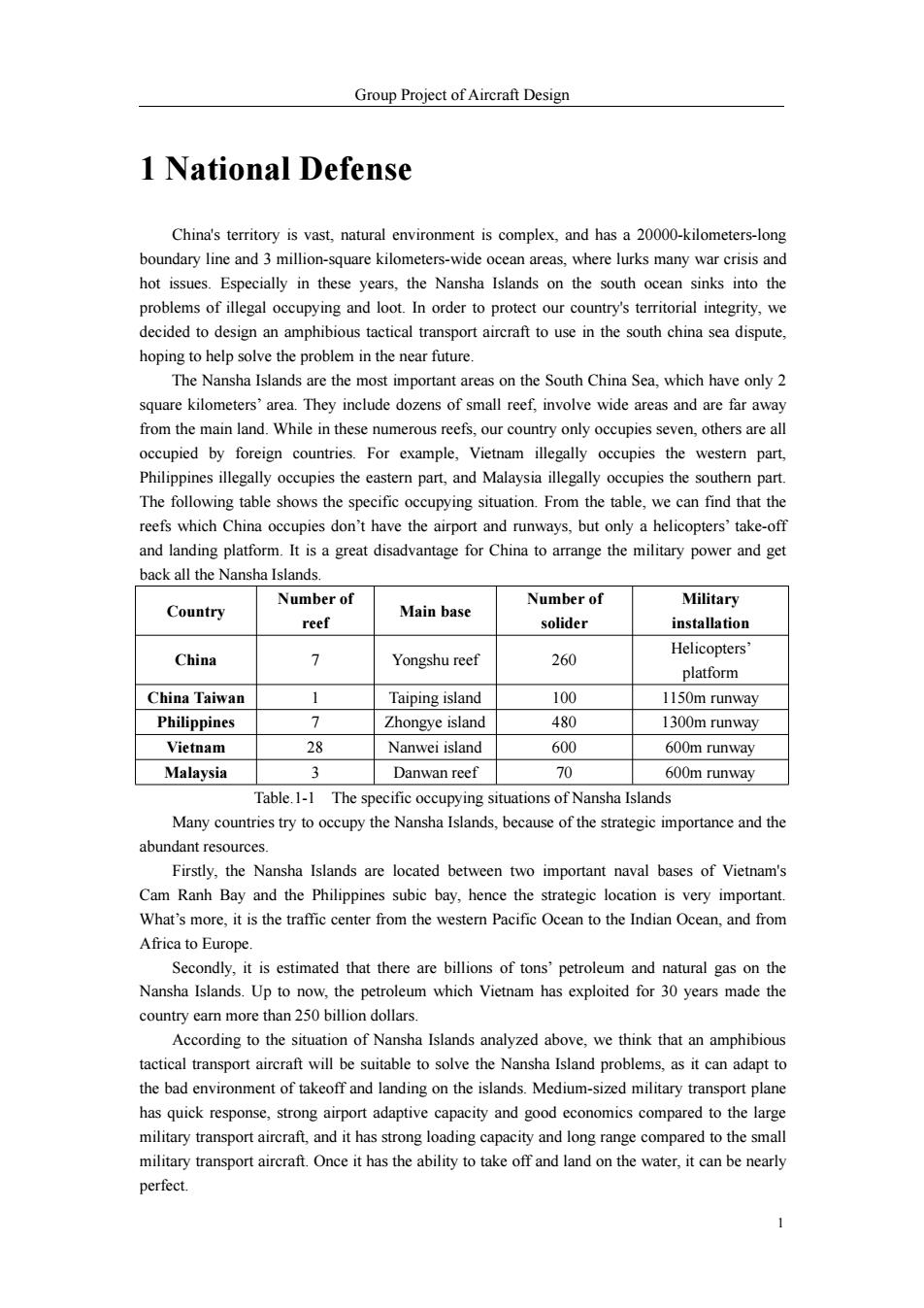
Group Project of Aircraft Design 上游充通大 Conceptual Design of an Amphibious Tactical Transport Aircraft Major: School of Aeronautics and Astronautics Name: Wang Meng 5124139010 Xu Yiran 5124139003 Ye Jiachen 5124139022 Zhang Pengyu 5124139016 Zheng Siyu 5124139005 Adviser: Dr.Song Wenbin 2015.7.5
Group Project of Aircraft Design Conceptual Design of an Amphibious Tactical Transport Aircraft Major: School of Aeronautics and Astronautics Name: Wang Meng 5124139010 Xu Yiran 5124139003 Ye Jiachen 5124139022 Zhang Pengyu 5124139016 Zheng Siyu 5124139005 Adviser: Dr. Song Wenbin 2015.7.5

Group Project of Aircraft Design Abstract Military transport aircraft has an important status in the national defense.Considering the serious situation of the Nansha Islands on the south ocean,we decide to design an amphibious tactical transport aircraft to apply to the national defense of south ocean.In this report,we will specifically design the layout,payload,wing,fuselage,boat,landing gear,tail wing,and choose a suitable kind of engine,and most excellent materials to make our aircraft better.In addition,we will analyze different performances and constantly adjust the parameters in order to have a better performance.And of course,the life-cycle cost analysis is also an important process as we would like to have the best economics.At last,we will make a comparison with other similar aircraft and give the model of our aircraft
Group Project of Aircraft Design Abstract Military transport aircraft has an important status in the national defense. Considering the serious situation of the Nansha Islands on the south ocean, we decide to design an amphibious tactical transport aircraft to apply to the national defense of south ocean. In this report, we will specifically design the layout, payload, wing, fuselage, boat, landing gear, tail wing, and choose a suitable kind of engine, and most excellent materials to make our aircraft better. In addition, we will analyze different performances and constantly adjust the parameters in order to have a better performance. And of course, the life-cycle cost analysis is also an important process as we would like to have the best economics. At last, we will make a comparison with other similar aircraft and give the model of our aircraft

Group Project of Aircraft Design Contents 1 National Defense....... ..1 2 Introduction of Transport Aircraft. 2 2.1 Brief Introduction and Classification 2 2.2 Civil Transport Planes......... .2 2.3 Abroad Transport Aircraft.... .6 2.4Seaplane .8 3 Primary Parameters Determination. 4 Initial layout......... 9 4.1 Introduction. 9 4.2 Airfoil.… .9 4.3 Fuselage.… 11 4.4 Tail Arrangement........ 12 4.5 Engine Placement....... 农 4.6 Landing Gear Layout....... 13 4.7 Initial Overall Layout..... 13 5 Preliminary Weight Estimation. 14 5.1 Introduction........ 14 5.2 Empty-weight Estimation. 15 5.3 Fuel Estimation...... 15 5.4 Weight Estimation Conclusion. 18 5.5 Wing loading Estimation........ 18 5.6 Thrust-to-weight Ratio............ .19 5.7 Synthetic Estimation of T/W and W/S. 20 5.8 The Conclusion of T/W and W/S.... 21 6 The Design of Fuselage....... 3 6.1 Introduction.… 22 6.2 Criteria.… 23 6.3 Terminology Definition.. 23 6.4 Detailed Design.… 24 6.5 Cockpit and Cabin...... 28 6.6Carg0D00r… 30 7 Boat Design.… 31 7.1 Hydrodynamic Layout..... 31 7.2 Principles of the Boat Design...... 32 7.3 Principal Dimension of Boat Body. 32 7.3 Step Design.… 33 7.4 Cross Section of the Boat. 33 7.5 Boat Shape................ 34 8 Wing Design… .35 8.1 Wing Shape Design................. .35
Group Project of Aircraft Design Contents 1 National Defense.............................................................................................................................. 1 2 Introduction of Transport Aircraft....................................................................................................2 2.1 Brief Introduction and Classification....................................................................................2 2.2 Civil Transport Planes...........................................................................................................2 2.3 Abroad Transport Aircraft..................................................................................................... 6 2.4 Seaplane.................................................................................................................................8 3 Primary Parameters Determination..................................................................................................8 4 Initial layout..................................................................................................................................... 9 4.1 Introduction........................................................................................................................... 9 4.2 Airfoil.................................................................................................................................... 9 4.3 Fuselage...............................................................................................................................11 4.4 Tail Arrangement.................................................................................................................12 4.5 Engine Placement................................................................................................................12 4.6 Landing Gear Layout.......................................................................................................... 13 4.7 Initial Overall Layout..........................................................................................................13 5 Preliminary Weight Estimation...................................................................................................... 14 5.1 Introduction......................................................................................................................... 14 5.2 Empty-weight Estimation................................................................................................... 15 5.3 Fuel Estimation................................................................................................................... 15 5.4 Weight Estimation Conclusion............................................................................................18 5.5 Wing loading Estimation.....................................................................................................18 5.6 Thrust-to-weight Ratio........................................................................................................19 5.7 Synthetic Estimation of T/W and W/S................................................................................20 5.8 The Conclusion of T/W and W/S........................................................................................21 6 The Design of Fuselage..................................................................................................................22 6.1 Introduction......................................................................................................................... 22 6.2 Criteria.................................................................................................................................23 6.3 Terminology Definition.......................................................................................................23 6.4 Detailed Design...................................................................................................................24 6.5 Cockpit and Cabin...............................................................................................................28 6.6 Cargo Door..........................................................................................................................30 7 Boat Design.................................................................................................................................... 31 7.1 Hydrodynamic Layout........................................................................................................ 31 7.2 Principles of the Boat Design..............................................................................................32 7.3 Principal Dimension of Boat Body.....................................................................................32 7.3 Step Design......................................................................................................................... 33 7.4 Cross Section of the Boat....................................................................................................33 7.5 Boat Shape...........................................................................................................................34 8 Wing Design...................................................................................................................................35 8.1 Wing Shape Design.............................................................................................................35

Group Project of Aircraft Design 8.2 Wing Geometry Optimization..... 41 9 Tail Geometry and Arrangement. 46 9.1 Tail Functions........ 46 9.2 Tail Arrangement............ 46 9.3 Horizontal Tail Parameters. 48 9.4 Vertical Tail Parameters. 51 9.5 Area of Tail 52 10 Engine. 53 10.1 Introduction 53 10.2 Choice of Engine Type. 54 10.3 Engine Installation...... 56 1 1 Landing gear.… 57 11.1 Landing Gear Arrangements. 少 11.2 Tire Sizing and Number.............. 58 l2 Refined Weight.… 59 12.1 Weight of Components.......... .59 12.2 Weight and Center of Gravity Estimation. 61 13 Lift and Drag Estimation.............. …62 13.1 Lift Estimation......... 62 13.2 Drag Estimation 64 14 Flight Performance....... 66 14.1 Takeoff Performance 67 14.2 Climb Performance. 68 14.3 Cruise Performance. 69 14.4 Landing Performance.......... 70 14.5 Summary...... 71 15 Hydrodynamic Performance........ 71 15.1 Force Analysis.......... 71 15.2 Takeoff Performance..... 73 16 Materials.… 77 16.1 Introduction. 77 16.2 Airframe Material Selection........ 79 16.3 Wing Material Selection.......... 79 16.4 Landing Gear Material Selection.... 80 17 Life-cycle Cost Analysis............ 81 17.1 Introduction. 81 17.2 RDT&E and Production Cost Analysis. 82 17.3 Operation and Maintenance Costs. 84 17.4 LCC Conclusion....... 86 18 Conclusion. 86 Acknowledgment. 88 Reference........ 88
Group Project of Aircraft Design 8.2 Wing Geometry Optimization.............................................................................................41 9 Tail Geometry and Arrangement....................................................................................................46 9.1 Tail Functions......................................................................................................................46 9.2 Tail Arrangement.................................................................................................................46 9.3 Horizontal Tail Parameters..................................................................................................48 9.4 Vertical Tail Parameters...................................................................................................... 51 9.5 Area of Tail..........................................................................................................................52 10 Engine...........................................................................................................................................53 10.1 Introduction....................................................................................................................... 53 10.2 Choice of Engine Type......................................................................................................54 10.3 Engine Installation............................................................................................................ 56 11 Landing gear.................................................................................................................................57 11.1 Landing Gear Arrangements............................................................................................. 57 11.2 Tire Sizing and Number.................................................................................................... 58 12 Refined Weight.............................................................................................................................59 12.1 Weight of Components......................................................................................................59 12.2 Weight and Center of Gravity Estimation.........................................................................61 13 Lift and Drag Estimation..............................................................................................................62 13.1 Lift Estimation.................................................................................................................. 62 13.2 Drag Estimation................................................................................................................ 64 14 Flight Performance.......................................................................................................................66 14.1 Takeoff Performance......................................................................................................... 67 14.2 Climb Performance........................................................................................................... 68 14.3 Cruise Performance...........................................................................................................69 14.4 Landing Performance........................................................................................................70 14.5 Summary........................................................................................................................... 71 15 Hydrodynamic Performance........................................................................................................ 71 15.1 Force Analysis...................................................................................................................71 15.2 Takeoff Performance......................................................................................................... 73 16 Materials.......................................................................................................................................77 16.1 Introduction....................................................................................................................... 77 16.2 Airframe Material Selection..............................................................................................79 16.3 Wing Material Selection....................................................................................................79 16.4 Landing Gear Material Selection......................................................................................80 17 Life-cycle Cost Analysis.............................................................................................................. 81 17.1 Introduction....................................................................................................................... 81 17.2 RDT&E and Production Cost Analysis............................................................................ 82 17.3 Operation and Maintenance Costs.................................................................................... 84 17.4 LCC Conclusion................................................................................................................86 18 Conclusion....................................................................................................................................86 Acknowledgment...............................................................................................................................88 Reference...........................................................................................................................................88

Group Project of Aircraft Design 1 National Defense China's territory is vast,natural environment is complex,and has a 20000-kilometers-long boundary line and 3 million-square kilometers-wide ocean areas,where lurks many war crisis and hot issues.Especially in these years,the Nansha Islands on the south ocean sinks into the problems of illegal occupying and loot.In order to protect our country's territorial integrity,we decided to design an amphibious tactical transport aircraft to use in the south china sea dispute, hoping to help solve the problem in the near future. The Nansha Islands are the most important areas on the South China Sea,which have only 2 square kilometers'area.They include dozens of small reef,involve wide areas and are far away from the main land.While in these numerous reefs,our country only occupies seven,others are all occupied by foreign countries.For example,Vietnam illegally occupies the western part, Philippines illegally occupies the eastern part,and Malaysia illegally occupies the southern part. The following table shows the specific occupying situation.From the table,we can find that the reefs which China occupies don't have the airport and runways,but only a helicopters'take-off and landing platform.It is a great disadvantage for China to arrange the military power and get back all the Nansha Islands. Number of Number of Military Country Main base reef solider installation China 7 Yongshu reef Helicopters' 260 platform China Taiwan Taiping island 100 1150m runway Philippines > Zhongye island 480 1300m runway Vietnam 28 Nanwei island 600 600m runway Malaysia 3 Danwan reef 70 600m runway Table.1-1 The specific occupying situations of Nansha Islands Many countries try to occupy the Nansha Islands,because of the strategic importance and the abundant resources. Firstly,the Nansha Islands are located between two important naval bases of Vietnam's Cam Ranh Bay and the Philippines subic bay,hence the strategic location is very important. What's more,it is the traffic center from the western Pacific Ocean to the Indian Ocean,and from Africa to Europe. Secondly,it is estimated that there are billions of tons'petroleum and natural gas on the Nansha Islands.Up to now,the petroleum which Vietnam has exploited for 30 years made the country earn more than 250 billion dollars. According to the situation of Nansha Islands analyzed above,we think that an amphibious tactical transport aircraft will be suitable to solve the Nansha Island problems,as it can adapt to the bad environment of takeoff and landing on the islands.Medium-sized military transport plane has quick response,strong airport adaptive capacity and good economics compared to the large military transport aircraft,and it has strong loading capacity and long range compared to the small military transport aircraft.Once it has the ability to take off and land on the water,it can be nearly perfect. 1
Group Project of Aircraft Design 1 1 National Defense China's territory is vast, natural environment is complex, and has a 20000-kilometers-long boundary line and 3 million-square kilometers-wide ocean areas, where lurks many war crisis and hot issues. Especially in these years, the Nansha Islands on the south ocean sinks into the problems of illegal occupying and loot. In order to protect our country's territorial integrity, we decided to design an amphibious tactical transport aircraft to use in the south china sea dispute, hoping to help solve the problem in the near future. The Nansha Islands are the most important areas on the South China Sea, which have only 2 square kilometers’ area. They include dozens of small reef, involve wide areas and are far away from the main land. While in these numerous reefs, our country only occupies seven, others are all occupied by foreign countries. For example, Vietnam illegally occupies the western part, Philippines illegally occupies the eastern part, and Malaysia illegally occupies the southern part. The following table shows the specific occupying situation. From the table, we can find that the reefs which China occupies don’t have the airport and runways, but only a helicopters’ take-off and landing platform. It is a great disadvantage for China to arrange the military power and get back all the Nansha Islands. Country Number of reef Main base Number of solider Military installation China 7 Yongshu reef 260 Helicopters’ platform China Taiwan 1 Taiping island 100 1150m runway Philippines 7 Zhongye island 480 1300m runway Vietnam 28 Nanwei island 600 600m runway Malaysia 3 Danwan reef 70 600m runway Table.1-1 The specific occupying situations of Nansha Islands Many countries try to occupy the Nansha Islands, because of the strategic importance and the abundant resources. Firstly, the Nansha Islands are located between two important naval bases of Vietnam's Cam Ranh Bay and the Philippines subic bay, hence the strategic location is very important. What’s more, it is the traffic center from the western Pacific Ocean to the Indian Ocean, and from Africa to Europe. Secondly, it is estimated that there are billions of tons’ petroleum and natural gas on the Nansha Islands. Up to now, the petroleum which Vietnam has exploited for 30 years made the country earn more than 250 billion dollars. According to the situation of Nansha Islands analyzed above, we think that an amphibious tactical transport aircraft will be suitable to solve the Nansha Island problems, as it can adapt to the bad environment of takeoff and landing on the islands. Medium-sized military transport plane has quick response, strong airport adaptive capacity and good economics compared to the large military transport aircraft, and it has strong loading capacity and long range compared to the small military transport aircraft. Once it has the ability to take off and land on the water, it can be nearly perfect